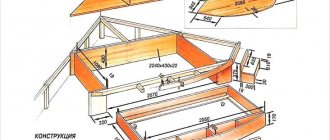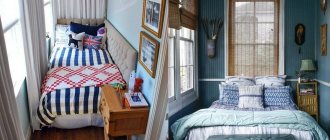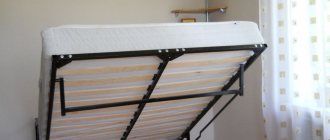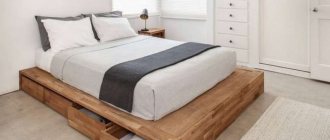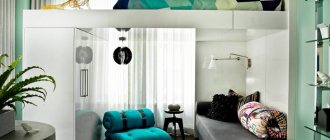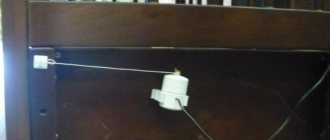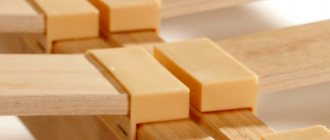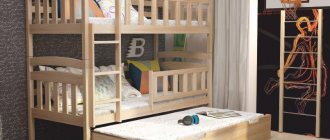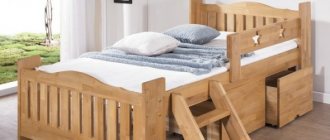Skip to content
Home » Beds » Single and one-and-a-half beds
Single and one-and-a-half beds
Reading time: 11 minutes. .4k.
A bedridden person needs special care. After all, even the most ordinary actions, such as eating or reading a book, become difficult to perform. To ensure comfortable conditions, not only outside help is needed, but also special devices. First of all, it is worth purchasing a bed for bedridden patients, which is multifunctional. Given the wide variety of models, you should understand their differences. Some are indispensable for the rehabilitation period after injuries, others improve the quality of life after paralysis. There are also universal options, but whether it is worth overpaying for those functions that are not needed is a moot point.
How to choose a bed for a bedridden patient
The main advantage of a multifunctional bed for a bedridden patient is the ability to change the positions of the sections and the height of the structure.
p, blockquote 3,0,0,0,0 —>
Immediately before purchasing a medical bed for a bedridden patient, we recommend consulting with your doctor. He will suggest the best design option.
If it is not possible to consult a doctor for advice when choosing a functional bed for a bedridden patient, pay attention not to the price of the bed or the brand, but to the functionality.
Articles on the topic (click to view)
- Differences between an ottoman and a bed
- Anatomical bed frame
- Differences between a sofa and a sofa
- How to choose the right foam density for a mattress
- Canape furniture: what is it
- How to beautifully hang a picture on the wall
- The best cleaner for leather furniture
p, blockquote 4,0,1,0,0 —>
Important! Exactly how many functions a bed should have depends on the diagnosis, age and health of the patient. Based on these data, make a choice.
Tips for correct bed positioning:
- you need to place the bed in such a way that the sun does not interfere during the day;
- provide an approach to the patient from all sides. This will make it easier to turn the patient from side to side;
- keep your bed clean.
p, blockquote 6,0,0,0,0 —>
A correctly selected and located sleeping place contributes to the speedy rehabilitation of a person.
Main types of structures
Beds for patients are divided into four modifications:
- single-section is one of the simpler bed options. This design only has adjustment of the head part;
- two-section - the bed has a mechanism for adjusting the head and foot parts;
- three-section - the design has the function of changing the position of the head, hip and leg parts;
- four-section. This bed has four adjustable parts.
p, blockquote 8,0,0,0,0 —>
There is also a special design equipped with adjustable and separable sections - you can completely customize the bed to suit the patient’s needs.
Types of medical beds for bedridden patients
Drive type
All models can be divided into two large groups according to the type of drive used in their design.
It can be automatic or mechanical. Adjustment of mechanically driven beds is done manually, that is, in order to change the position of the bed, you need to lift a separate section and secure it. This option is not very convenient, especially if the patient is unable to rise on his own or is heavy. A more advanced mechanical modification is the “worm” drive, when the sections are lifted due to the movement of screw levers.
Mechanical medical beds are less expensive and are suitable for patients who do not require frequent changes in body position.
Electric beds can be:
- pneumatic, when adjustment is carried out using special springs;
- electric - these are the most advanced models, the angle of inclination in which can be changed by pressing the corresponding buttons on the remote control .
The patient can adjust the electric bed without assistance, changing the angle of the sections at any moment.
Number of sections
A special feature of medical beds is the presence of special sections.
Their adjustment to different heights allows you to give the human body an optimal position in which it will be as comfortable as possible. The number of sections can be from one to four. In single-section beds, only the part located under the head is raised. This allows the patient to eat comfortably and reduces the load on the cervical spine.
In two-section models, the leg part is also adjustable, which is valuable in trauma departments, where it is important for patients to change the position of their limbs. The three-sectional one adds the ability to raise the hip part, and the four-sectional one adds the ability to lift the intermediate parts of the body.
On sale you can find beds that transform into an armchair.
Availability of additional functions
The design of the bed is often complemented by side lattice railings, which can be removed at the right time.
With their help, the safety of the patient is ensured, who is deprived of the opportunity to end up on the floor. When the barriers are removed, doctors and nurses have free access to perform procedures and care for the patient. The rotating bed function allows you to conveniently turn the patient on his side. The presence of a toilet device in some models also turns out to be irreplaceable .
Beds can have legs that are adjustable in height - and this is important if a bedridden patient leaves the room every day and goes for procedures. Some models may be equipped with wheels and a braking system. In this case, there is no need to transfer the patient onto a couch or into a chair, since transportation is carried out directly on the bed.
Useful additions include a serving table, at which a bedridden person can eat food.
Other options
Medical beds are made for both adults and children.
They can be used in special institutions and departments (burn, postpartum, trauma, etc.), as well as at home, when an orthopedic bed with a lifting mechanism for the disabled becomes the most popular. For the production of furniture, modern materials are used - light, strong, durable and practical. Individual parts can be easily removed for cleaning, which eliminates the development of infections.
Mechanism type
The sections can be adjusted electrically or mechanically. The cost of options from the first category is slightly more expensive. Adjustment using a mechanical component occurs according to the clamshell principle. Thus, lowering or raising various sections must be done manually. The latch moves to the desired position.
p, blockquote 10,0,0,0,0 —>
p, blockquote 11,0,0,0,0 —>
There is another way of adjustment. To change the height of the section, you need to tighten the screw lever.
p, blockquote 12,0,0,0,0 —>
The product must also have a height adjustment mechanism. This is an important factor, especially for people with disabilities. The height can be adjusted electrically and mechanically. For people with disabilities, the electric option is more suitable.
How to buy the right model
The main thing you pay attention to when buying sideboards is compatibility with the bed model. It determines the installation method and type of fastening elements. They must match the grooves on the body. The dimensions of the frames are usually standard, they correspond to the standard dimensions of medical beds, although models adapted to home furniture are also available for sale. These fences are available in different colors. There are even welded grilles with decorative elements.
Before purchasing, the characteristics of the support device are correlated with the patient’s body weight, height and physical condition. Pay attention to the maximum load and methods of fastening the sides.
If the design allows for height adjustment, the control mechanism must be safe. Most often, push-button locks are used as locks.
The fencing kit may include two or four wings, which are mounted on both sides of the frame. Parts of the sides are folded back independently of each other, which increases the functionality of the system.
The fasteners for the system must be strong so that they can support the weight of the patient if he leans on the railing. The railing elements must fit snugly against the bed frame. Installation is carried out using brackets, bolts, rotary eccentric clamps.
When purchasing a bed support, it is recommended to ask the seller what equipment it is compatible with, what accessories can be purchased, and whether consumables are provided to improve the functionality of the structure.
The technical description, which is attached to the fencing kit, contains detailed information about the characteristics of the product and describes the assembly and installation procedure.
The technical characteristics of bed rails, additional devices and accessories determine the price. The most economical option is a collapsible steel structure. This compact guard fits under the mattress and is supported by the patient's weight. True, the load limit for it is only 100 kg. Metal railings installed in special grooves are more stable, but also cost more. The price for models with a reinforced frame is even higher.
Classification by type of raw material and type of drive
The structures are made from:
- metal;
- plastic;
- combined components;
- wood.
p, blockquote 14,0,0,1,0 —>
If we compare structures in terms of strength, then a metal bed is in the lead. In terms of reliability and environmental safety, plastic is the best. It is often possible to find when the first two materials are combined. Thanks to this, only the best quality beds are used.
p, blockquote 15,0,0,0,0 —>
Hospital beds are occasionally made of wood. They look homey and are comfortable to lie on. Sometimes such options are purchased for bedridden patients who are undergoing outpatient treatment.
p, blockquote 16,0,0,0,0 —>
Based on the type of drive, the following beds are distinguished:
- Motorized. The patient himself sets the comfortable position of his bed using the remote control. An assistant or caregiver can also use it. Mechanical procedures are performed by electric motors powered by electricity. There are products for bedridden patients with a turning function. They are equipped with an emergency power system from standard batteries.
- Mechanical. Here, patients will not be able to adjust the position of the bed on their own, since this is done manually. In hospitals this is done by nurses, and at home by nurses or caregivers. Typically, such an invention is made on the basis of screw elements that are adjusted by hand. This is not difficult to do. The main thing is that the person feels comfortable.
h2 4,0,0,0,0 —>
Choosing a functional bed for a bedridden patient
Injuries, strokes, diseases of the musculoskeletal system, senile pathologies, and the postoperative period become the root cause of forced bed rest, which can last for a long time. For such patients, the bed becomes the only place in the house where they have to sleep, eat, take medical and hygienic procedures, relieve natural needs, read, watch TV, and communicate with relatives and friends.
At the same time, a bedridden patient should not experience additional suffering from furniture that is unsuitable for his needs. Close people try to take care of creating optimal conditions for therapy and special medical beds help them with this.
Types for bedridden patients
A medical bed for bedridden patients is distinguished by the presence of separate adjustable sections (their number varies). This allows you to choose the most comfortable angle of the bed. In some cases, it is necessary to fix the product in a semi-sitting or sitting position, and then smoothly, without jerking, bring it back to a horizontal direction.
Also, a medical bed for lying down allows you to tilt the patient to the right or left, which is extremely important in some cases of the postoperative period. To prevent the occurrence of bedsores, a special function of shifting the pelvic section is used. Almost all products are equipped with wheels. They make it easier to transport patients.
Manufacturers offer a wide range of couches for bedridden patients. Among the popular models:
- Two-section functional medical couch - a model with a metal bed and wooden side backs, a screw mechanism for changing the angle of the sections;
- Metal bed with 4 section base and screw adjustment of the head section or all other sections. The budget option is suitable for a hospital department, with the exception of the ICU;
- A three-section bed-chair with a toilet device - the leg section goes down, thereby the product takes the “cardio chair” position. It is necessary during the treatment of many cardiovascular diseases. The model is equipped with removable backrests and a built-in toilet. It is possible to transport the patient in a sitting position;
- A three-section bed that transforms into an armchair with a table, an electric toilet and an anti-decubitus mattress is equipped with a “cardio chair” function. Allows the patient to use the toilet independently using an electric drive;
- A functional four-section couch with height adjustment and electric drive - this model is very similar to ordinary home beds and will fit perfectly into the interior. An orthopedic bed, 4 adjustable sections, and a control panel will make patient care possible even at home.
Two-piece couch
With height adjustment
With toilet
Metal
With a table
What problems do medical beds solve?
Medical functional beds take into account all aspects related to the care and satisfaction of the needs of immobilized patients. To ensure safety and comfort, it is not necessary to place fence chairs near the bed, cover the patient with pillows and blankets, bring feeding tables, or tie ropes to enable independent lifting.
Many who have decided to buy a medical bed are probably familiar with the futile attempts to create feasible amenities for a bedridden family member.
People who are forced to take on the responsibilities of caring for bedridden patients know firsthand what a huge burden falls on the shoulders of the care staff. Constant attention and physical efforts (lifting, turning over) often border on the risk of spinal injury and have a negative impact on the well-being of caregivers.
A functional medical bed solves two problems simultaneously:
- creates favorable conditions for an incapacitated patient;
- makes the work of those who care about him easier.
Review of medical beds
If a person has never had to care for a seriously ill person, he most likely does not know how a medical functional bed differs from a regular one.
At best, I remember a lifting headboard and wheels. In fact, a medical bed has many accessories and functions necessary for a particular disease. They are used both in hospitals and at home when caring for an elderly or sick person. Before purchasing a medical bed, you must consult a traumatologist or orthopedist. The fact is that in addition to the functional features of the bed, which are understandable even to a non-professional, there are such nuances as the hardness of the mattress, an anti-decubitus system, special accessories, etc. The doctor will help you understand the intricacies and give recommendations for a specific case.
Bed selection criteria
What is the best guide when choosing a medical bed, your ability to pay? Not always. First of all, it is advisable to decide what tasks the product will face.
A completely paralyzed person will require some functions, while someone who has retained relative mobility will require others. In order not to overpay for unnecessary ones and save on vital ones, it is advisable to understand in advance what “smart” beds can do.
Number of sections
The main parameters by which medical beds are classified are the number of moving elements and the control method. You can change the position of the patient’s body by setting a certain angle of inclination (rotation) of one or several movable segments at the same time.
The minimum number of sections or segments is two; these are simple and inexpensive models with a movable head compartment. Despite the apparent simplicity, the design of the bed allows you to raise the patient’s head, shoulders and body by 45-80º without any extra effort.
This position is needed when feeding, it facilitates breathing and the functioning of the digestive organs, and relieves tension from the cervical and thoracic spine.
In the three-section model, you can additionally lower and raise the foot part. The function is in demand for patients with problems in the lower extremities: it will not allow you to slide down, it will reduce congestion in the legs, lungs, and abdominal cavity.
For seriously ill people, completely immobilized or for those who have to constantly remain in a lying position, four or more sectional beds have been developed.
The bed of such models contains several intermediate controlled segments and a fixed compartment in the pelvic area. Each section, after installation, ensures a physiologically correct body position, which guarantees patient comfort and simplifies care.
This type of bed can be transformed into a cardio chair, which increases the mobility of an immobilized person and helps in the treatment of cardio diseases.
Types of drives
You can control the sections and change the height of the bed mechanically or using an electric drive. In some models, the adjustment methods are interchangeable, which is important in the event of a power outage.
The medical functional bed with mechanical drive is equipped with sliding supports, hydraulic drive or screw levers. All these mechanisms are operated manually, which must be taken into account when choosing a product.
Expert opinion
Smirnova Ekaterina Anatolevna
7 years of experience in interior design, professional architect
It is better to first find out the principle of operation and the proportionality of the applied efforts to the individual characteristics of the patient from the store consultant.
Operating a bed with an electric motor is easier and more enjoyable. Control buttons are located on the side panel or on the remote control.
With a slight movement of the hand, the bed relief required for the patient is adjusted, the body position is fixed, and the turning function is performed. While maintaining hand mobility and clarity of consciousness, a person is able to take care of comfort himself, which has a beneficial effect on his psychological state.
For a caregiver, this is an opportunity to relax or switch to other household chores.
Additional accessories
Medical beds have a number of other advantages that are important for the convenience of patient care:
- removable or foldable side rails;
- adjustable end backrests;
- arc for pulling up;
- sanitary device (retractable vessel);
- infusion stand;
- bath for washing hair;
- bedside table;
- caster wheels with individual brakes;
- sectional mattress.
The design of the bed plays an important role in the calm and relaxed state of the patient in bed. It is not a single monolithic canvas, but a mesh of durable metal or wooden planks. This frame provides optimal air exchange and an orthopedic effect for a recumbent user.
Dimensions
Products are delivered unassembled, which simplifies transportation and storage. However, it is advisable for buyers to decide in advance where the bed will be placed.
The correct positioning of the product will allow you to freely approach the patient, perform manipulations, fully manage the bed, clean the room, as well as the ability to fold the bed if necessary.
For a person locked within four walls, it is important to observe what is happening around him: who has entered the room, what is happening on the street. This nuance must also be taken into account when placing furniture.
Types of medical beds by base type
The selection of furniture must be approached responsibly. You should be especially careful when choosing a bed based on the type of base. The basic functionality, convenience, practicality, and durability of the bed will depend on it. For bedridden patients, models are made of plastic, metal and wood. The first option is attractive due to its ergonomics, light weight, ease of maintenance, and hygiene. Beds with a metal base are designed for high loads, long-term, intensive use. Most often they are purchased for medical institutions. Wooden analogues are chosen for the home to highlight the decor. An important requirement for them is the presence of a protective coating that increases the material’s resistance to moisture.
Bed bases differ in design features. They consist of a different number of sections. This determines the functions of the furniture. Two-section ones allow you to lift only the upper or lower part of the patient’s body. Multi-sectional ones include options for cardio chairs, inversions, etc.
Beds with toilet facilities are considered the most comfortable. They simplify hygiene procedures several times. Advanced models contain additional elements - a bedside or over-bed table, side rails, hair washing kits, clamps, various racks, etc.
Recommendations for selection
If you are confused by the variety of models of medical functional beds, a list of questions that are recommended to ask the seller will help you:
- How many sections does the bed have?
- What control method?
- What functions are provided?
- How much weight can the product support?
- What is included in the factory package?
- What guarantees exist and how are they implemented?
- Is it possible to rent or buy a used model?
Consultants from the online medical equipment store in Moscow “Med Tema” will help you select the necessary equipment for free, taking into account your individual needs, and answer your questions. The store works directly with manufacturers, which makes it easier to find a suitable bed option at an affordable price.
A comfortable, functional bed for a bedridden patient is a piece of essential furniture, an island of safety and a chance for a speedy recovery. It allows a person weakened by an illness to feel complete and independent, which is an important factor in the fight against the disease.
Selecting a mattress
Mattresses for medical beds have some features; they differ in size, shape, thickness, and material. By type of construction they are:
- Single-section;
- Two-section;
- Three-section;
- Four-section.
For bedridden patients, anti-bedsore mattresses for medical beds are required. Products vary, so when choosing them, pay attention to:
- Patient weight;
- Type of product (dynamic or static);
- Type of pressure ulcer prevention (balloon or cellular).
The mattress is selected based on the height and weight of the patient. There are products for patients with heavy weight. Orthopedic beds, or rather mattresses, can be static or dynamic. The surface of the first is stationary, however, it works in such a way that it adapts to the characteristics of the patient’s body. The mattress is able to follow all the curves of the body, and this prevents the appearance of increased load in certain areas. A dynamic mattress has a movable surface. Constant movement is an excellent prevention of bedsores. In addition, this model has a massage effect, so the patient’s blood circulation improves.
A cellular mattress is a canvas divided into small compartments. It is recommended to choose such products for patients with stage 1-2 pressure ulcers. Patient weight limit is up to 110 kg. The balloon model is similar to an air mattress with transverse chambers. It is suitable for patients with stage 3-4 bedsores. The patient's weight limit is up to 120 kg.
A medical bed with a toilet must be equipped with a mattress that does not absorb moisture. These products consist of a polyurethane foam block and a removable cover. The cover is a medical oilcloth on a fabric basis. There is a zipper around its perimeter. It is recommended to purchase a waterproof mattress for a medical bed with a hole. The built-in toilet is easy to clean, and the opening is covered with a soft section.
Beds for bedridden patients at home
- Size 190*90*6 cm
- Two-section
- With toilet valve
- Removable cover with zipper
- 4-section
- Size 215*95*50 cm
- Back section tilt angle 0-75°
- Angle of the ankle section 0-45 °
- Load capacity 220 kg
- Weight 71 kg
- Bed size 199*89.5 cm
- Cardio chair function
- Maximum weight 180 kg
- Size 200*85*8 cm
- PVV filler
- Comfort fabric cover (waterproof)
- Size 198*88*8 cm
- Anti-slip coating
- Removable cover with zipper
- 4 sections
- Bed size 195*90 cm
- Number of functions 2
- Load capacity 180 kg
- Bed size 195*90 cm
- Bed height from floor 51 cm
- Number of cradle sections 4
- Number of functions 2
- Load capacity 135 kg
- Size 190*90*6 cm
- Bath valve
- Toilet valve
- Removable cover with zipper
- Bed size 193*90 cm
- Steel bed - 2 sections
- Weight 60 kg
- Load capacity 200 kg
- Made of steel
- Number of sections 10
- Bed size 199*89.5 cm
- Electric drive
- Infusion stand
- Pull-up device
- Toilet device
- Cardio chair function
- Maximum weight 180 kg
- 4 sections
- Bed size 195*90 cm
- Number of functions 2
- Load capacity 180 kg
- Number of sections 4
- Bed size 198*90 cm
- Electric drive
- Infusion stand
- Pull-up device
- Table and toilet unit included
- Cardio chair function
- Load capacity 180 kg
- Size 193*80*50 cm
- Weight 10 kg
- White color
- Dimensions: 1260x780x25
- For beds: f-01, f2-01, f3-01, f4-01
- Size 176*75*6 cm
- Single section
- Removable cover with zipper
- Bed size 205*96*92 cm
- Bed height (from the floor) 50 cm
- Number of cradle sections 4
- Number of functions 2
- Load capacity 135 kg
- Electric drive
- Mechanical drive
- 4 sections
- Bed size 193.5*89.5 cm
- Maximum load 185 kg
- Number of cradle sections 4
- Bed size 195*90 cm
- Load capacity 200 kg
- 3 functions
- 4 sections
- Bed size 197*90 cm
- Load capacity 180 kg
- 3 functions
- Electric drive
- Bed width 100 cm
- Folding side rails
- Section adjustment
- Rollover and cardio chair functions
- Toilet device
- Overbed table
- Size 195*82*12 cm
- Anti-decubitus and “anti-greenhouse” effect
- Polyurethane foam filler
- Electric drive
- Bed dimensions 192*90 cm
- Bed height from 49 to 69 cm
- Section adjustment
- Cardio chair function
- Toilet device
- Overbed table
- Anti-bedsore mattress
- Electric drive, wired remote control
- 4 stock sections
- Bed size 192*90 cm
- Flip function
- Cardiac chair function
- Toilet device
- USB charging
- Mattress included
- Maximum load 200 kg
- Number of sections 4
- Bed size 198*90 cm
- Electric drive
- Infusion stand
- Pull-up device
- Table included
- Cardio chair function
- Maximum weight 180 kg
- Bed size 200*90 cm
- Number of sections 4
- Load capacity 180 kg
- Electric drive
- Number of sections: 2
- Drive: Mechanical
- Adjustment Mechanism: Open, Folding
- Adjustment: Head section
- Head section tilt angle: 0° to 70°
- Maximum total load, kg: 200
- Bed size 196*90 cm
- Steel bed - 2 sections
- Weight 60 kg
- Load capacity 200 kg
- Size 74*40*6 cm
- Single section
- Removable cover with zipper
- Wheel diameter 4 cm
- Material: steel
- Load capacity 3 kg
- Electric drive
- Bed dimensions 192*90 cm
- Bed height from 49 to 69 cm
- Section adjustment
- Cardio chair function
- Toilet device
- Overbed table
- 7 cradle sections
- Mechanical drive
- Bed size 199*90 cm
- Maximum weight 180 kg
- Cardio chair function
- Made of steel
- Number of sections 4
- Bed size 198*90 cm
- Electric drive
- Infusion stand
- Pull-up device
- Table and anti-decubitus mattress included
- Cardio chair function
- Maximum weight 180 kg
- Bed size 195*100 cm
- 4 stock sections
- Flip function
- Cardiac chair function
- Integrated wheelchair
- Toilet device
- Orthopedic mattress
- Maximum load 220 kg
- Bed size 197*90 cm
- 4 sections
- Steel frame
- Cardio seat function
- Antitrendelenburg function
- 2 mattresses, table, stand, bar, bath
- Maximum load 180 kg
- Number of cradle sections 4
- Bed size 195*90 cm
- Load capacity 200 kg
- 3 functions
- 4 sections, Electric drive
- Bed size 200*90 cm
- Number of functions 5
- Load 180 kg
- Weight 100 kg
- 4-section medical bed
- Remote control
- Patient elevation device
- Electric drive Linak
- Rastomat mechanism
- Adjusting the angle of sections
- Mattress frame tilt: 10 degrees
- Bed height adjustment
- Side rails, back, foot - wood
- Dimensions of the mattress frame (bed) 200 x 90 cm
- Bed size 200*90 cm
- 4-section base with steel slats
- Electric drive “Linak”
- 4-section model
- Electric drive
- Wooden slats
- Beech side railings
- Mattress base size 200 x 90 cm
- Max. load 185 kg
- 4 section
- With height adjustment from 40–80 cm and tilting foot end
- Electric drive "Linak" (Denmark), remote control
- Dimensions of the mattress base - 200x90 cm
- Includes: foam mattress with zippered cover and arch for lifting/pulling
- 4-section system
- Steel perforated cradle
- The back, hip and ankle sections are adjustable according to the angle of inclination
- Trendelenburg/Anti-Trendelenburg position
- Bed size: 195x89 cm
- Bed height: 47.5-77 cm
- Load capacity: 250 kg
- Water-repellent fabric
- Size L*W*H 190*85*8 cm
- Net weight 2 kg
- Cotton
- Width 120 cm
- 2 pcs. packaged
- Tensioners
- 4-section bed
- Metal slats
- Electrical adjustment of sections and bed height
- Except for the intermediate section, all sections are adjustable in angle of inclination
- Remote control
- Trendelinburg/anti-Trendelinburg position.
- Fencing made of wood materials
- 4 wheels, equipped with brakes and individual locking
- Bed length 215 cm.
- Bed width 103 cm.
- Max. permissible load 175 kg
- Four-section bed with mattress
- Electrical adjustment of sections and bed height
- Telescopic guide system with ball support for raising and lowering.
- Fences are made of natural beech
- Trendelinburg/anti-Trendelinburg position.
- Holders (4 pcs.) prevent the mattress from sliding on the bed
- Use of assistive technical means of rehabilitation
- Max. permissible load 175 kg.
- 4-section
- Electric adjustment of sections and bed height.
- Use of assistive technical means of rehabilitation
- Trendelinburg position
- Lift for boarding
- Bed length 215 cm
- Bed width 103 cm.
- Bed size 196*90 cm
- Steel bed - 2 sections
- Weight 56 kg
- Load capacity 200 kg
- 4-section
- Control: electric drive
- Cardio chair function
- Back section tilt angle: 0-70 degrees
- Thigh section angle: 0-35 degrees
- Anti- and Trendelenburg position:
- Battery life: 6-8 hours
- Bed dimensions: 200 x 89 cm
- Maximum user weight: 170 kg
- Electric drive
- Bed size 199*89.5 cm
- Steel frame
- Folding side rails
- 10 stock sections
- Rollover and cardio chair functions
- Toilet device
- Overbed table
- Anti-bedsore mattress
- Maximum load 180 kg
Functions of modern medical beds
1. Adjustment of the head (back) section
The section on which the back and head rests rises to a certain angle (on average 75°) and is fixed in this position, allowing the patient to half sit and half lie down. In this position it is convenient to eat, watch TV, read, work on a laptop or tablet. In addition, in this position the digestive and respiratory systems function better.
The backrest angle is adjustable in three ways:
- Using an electric drive. The backrest rises and falls when you press a button on the remote control.
- Using a screw drive. The backrest rises and falls when a special lever at the foot of the bed is rotated.
- Using a mechanical drive (step adjustment). The backrest rises and is fixed in special gaps, similar to those provided in sun loungers.
2. Adjustment of the foot section
The angle of the leg section can also be adjusted using a mechanical, screw or electric drive. The position of the leg section needs to be changed to avoid numbness in the legs or to move the bed into a “cardio chair” position.
3. Height adjustment
The height of the bed is adjusted using a worm, mechanical or electric drive. When the bed is in a low position, it is convenient for the patient to sit on the bed and put his feet on the floor. The high position of the bed makes it convenient for caregivers and doctors to carry out procedures.
4. Adjustment of the angle of the bed (Trendelenburg/Anti-Trendelenburg position)
A bed equipped with this function can be placed in a position where the legs are raised (Trendelenburg) or when the front is raised (Anti-Trendelenburg).
In the Trendelenburg position, the patient lies on his back and his pelvis is elevated at an angle of 45° relative to the head.
5. CPR. Cardiopulmonary resuscitation system
This function allows you to smoothly, without jerking, but in an emergency, move the bed from any position to a completely horizontal position for performing cardiopulmonary resuscitation.
Useful functions of beds for bedridden patients, popular model options
People after injuries, as well as during the recovery period after surgery, require special care. For them, manufacturers of medical equipment produce sleeping places that take into account the peculiarities of treatment and rehabilitation during this period.
Products such as a bed for bedridden patients are used not only in medical institutions, but also at home. Multifunctional models differ depending on the number of sections, drive type and other parameters.
Additional accessories make the couch comfortable and make caring for the patient easier.
How to choose an anti-decubitus mattress
If a person is bedridden, then a medical anti-decubitus bed for bedridden patients is selected for him. It is based on a special mattress, the design of which eliminates the possibility of bedsores .
Anti-decubitus mattresses can be:
- cellular - their internal small compartments are filled with air;
- balloon - there are several large compartments inside, which are also filled with air;
- without blowing and with blowing (in the latter version, a comfortable microclimate on the surface is maintained using special ventilation systems).
It is good if the mattress is waterproof and its cover is durable and easy to clean. In this case, unpleasant odors will not become a problem.
What is it and its main purpose?
A bed for bedridden patients is a sleeping place equipped for people with limited mobility. Models can have different types of drives and additional devices that will provide all the patient’s needs.
In addition, with the right choice of sleeping place, they will help restore body functions in a shorter period.
A functional bed will help a bedridden patient not to feel obligated to anyone. The models are made very comfortable and equipped with modern mechanisms that will help improve the patient’s condition. For some time, couches become a person’s permanent location.
The patient's mental state is important during the recovery period, so the most comfortable beds with additional elements will help improve the patient's mood. In this case, he will begin to recover faster.
The couches have several sections, individual elements can be adjusted, making it easy to change the patient’s position. For comfortable eating, you can choose a “half-sitting” position.
Sometimes it is necessary to tilt the patient to the right or left side, which is also easy to implement. This need is associated with the characteristics of the treatment or recovery period after surgery.
Purpose
A medical multifunctional bed can have a variety of functions and additional equipment. All models differ in the material of manufacture, the number of sections, and transformation options. Only a correctly selected bed for a specific case will help the patient’s speedy recovery, improve his condition, and provide the necessary conditions.
With the help of medical beds, a person with limited motor functions or a seriously ill patient will be much more comfortable. Modern mechanisms will provide everything necessary for recovery and make the rehabilitation period less burdensome for the patient and staff. The main purpose of medical beds is to ensure a comfortable stay for the patient throughout the entire period of treatment. Depending on the type, products are:
- For a hospital – beds on which patients rest during treatment;
- For inspection – they are installed in offices, most often represented by couches;
- For recovery from injuries - a special group of beds equipped with support devices for patients with limited mobility;
- Rolling beds - for transporting bedridden patients within the hospital, as well as in an ambulance.
Some patients need medical beds for home use. They can be purchased on specialized websites. The cost of the products may be too high, but it is possible to choose a used bed or rent one.
Model options
Nowadays, medical beds are produced by various manufacturers. Models may differ in many ways. According to the type of drive, couches come in the following types:
- mechanical sleepers are suitable for people if the angle of inclination of individual sections does not need to be constantly changed. This is due to the fact that changing position and other functions can only be performed manually. Sometimes it is necessary to use force to adjust the patient's position;
- Worm drive beds are equipped with special levers. Such models work smoothly. They require less force, unlike mechanical couches. If the control levers are no longer needed, they can be hidden;
- a product with a pneumatic spring allows you to tilt the patient due to a hydraulic drive;
- The most practical and comfortable to use are electric beds. They operate from a remote control mounted on the side. This type of bed is the most expensive. The patient himself is able to choose the angle of inclination he needs.
General hospital couches differ in the number of adjustable sections, and they are divided into one, two, three, and four sections. Separate bed compartments are needed for a rehabilitation course and are associated with the need to maintain a certain position of the patient’s body for a certain time.
There are models with a number of sections from 6 to 12. There is also a bed for bedridden patients with a turning function.
The bed for burn patients has a special design, as well as special devices. Manufacturers make such models so that they ensure a speedy recovery and alleviate the condition of patients. The bed can be used not only by burn patients, but also by people after operations or with bedsores.
The sleeping place has a special filler, which under air pressure creates a state similar to weightlessness. The patient seems to be “floating” in the bed.
This greatly relieves the pain of burns. Air of a certain temperature passes through special microspheres and dries the skin and promotes wound healing.
The pressure does not impede blood circulation.
Sometimes a multifunctional model is necessary for a person who is not in a medical facility, but at home. You can choose the most convenient and functional model in specialized stores.
Expert opinion
Smirnova Ekaterina Anatolevna
7 years of experience in interior design, professional architect
But the bed will be quite expensive, so if financial resources are limited, you can rent a couch or buy a used one.
An important point is the prevention of bedsores that form in people with problems with motor functions of the body. For this purpose, special mattresses or additional equipment are used to ensure that the pelvic compartment moves forward and backward. For ease of movement, almost all models have wheels.
Classification
All products differ in purpose, set of functions, number of sections, and types of transformation mechanisms. In addition, they are made from different materials. Each of the parameters affects not only practicality, but also cost.
By purpose
Depending on the set of functions, medical beds are intended for use at home or within the walls of a hospital. To ensure professional care, the following are installed:
- Beds for examining the patient.
- Simple designs for hospitals.
- Gurneys, which are also used in ambulances.
- Beds with supportive devices for injury recovery.
- Special products for burn patients.
Size options for one-and-a-half-bed beds depending on its purpose
The anti-burn medical bed is strikingly different from other models. The density of the furniture filler is equal to the density of water, so the pressure on the body is minimal. In addition, the material allows air to pass through, which speeds up wound healing and relieves pain.
Most models also provide dehydration, a horizontal lift, a timer, and other functional devices. Beds for burn patients are used only in specialized medical institutions. Other models can be purchased for your home. The more functions a product performs, the more you will have to pay.
For hospital
For ambulance
For patients with burns
With supportive devices for injury recovery
For inspection
By the number of adjustable sections
Medical beds for bedridden patients differ from other products in that they have separate sections that can be adjusted. Depending on the type of structure chosen, it can be fixed in any position, for example, sitting, or rotated to the right and left. The movable pelvic section prevents the formation of bedsores. Based on the number of sections, models are distinguished:
- Single-section - here only the head section is adjustable, which makes eating easier and makes it possible to change the position of the neck.
- Two-section - together with the head section, the leg section is also adjusted; such products are often used for leg injuries.
- Three-section - a pelvic section is added to the head and foot sections.
- Four-section - in such options, the head, pelvic, knee and femoral sections are most often combined.
Modern beds for patients include up to 12 adjustable sections. The importance of having any of them is determined only by the attending physician. Not all functions are useful in treating different diseases.
To facilitate transportation, functional beds for bedridden patients are equipped with rubber wheels.
Single-section
Two-section
Three-section
Four-section
According to the operating principle of the adjustments
Depending on the control method, hospital bed or similar home products are:
- Mechanical. Manual adjustment is assumed. It is possible to change the height and angle of inclination of various sections. Such beds are suitable only for those patients who do not need constant movement, which is partly a disadvantage. As for the advantages, such models are cheaper than others.
- On an air spring. The hydraulic drive of the structure allows you to place the shoulders and head below the level of the pelvis. Other models do not provide this feature. This type of bed is quite specific and is rarely used. The patient cannot use this furniture independently, which is certainly a disadvantage.
- With worm drive. Compared to mechanical structures, such models require less effort. With the help of special screw levers, the angle of the patient’s body changes in a matter of seconds. The only drawback, given the affordable cost and light weight, is the need for outside help.
- Electrical. The most functional, but most expensive beds. They are equipped with a control panel, so the patient can independently change the position of the body. They lose their superiority in the event of a power outage, although some models are specially equipped with mechanical control.
For stroke patients or those recovering from a serious injury, any of the options described are suitable. An electric bed is ideal for the home, as the design requires minimal human intervention. When choosing a product, you must also take into account its cost, quality and degree of functionality.
Electric
Worm driven
On an air spring
Mechanical
By size
Almost any bed for patients with two or more adjustable sections can be transported folded. It can be easily moved from place to place or stored in a small room. There are models in different sizes on the market.
The average dimensions of adult beds are 2.1 x 0.95 x 0.85 m. The size of the berth is 1.9 x 0.9 m. A mechanical bed for bedridden patients with a toilet or other functional devices weighs no more than 90 kg. The electric drive significantly makes the product heavier. The weight of such furniture varies from 100 to 165 kg.
